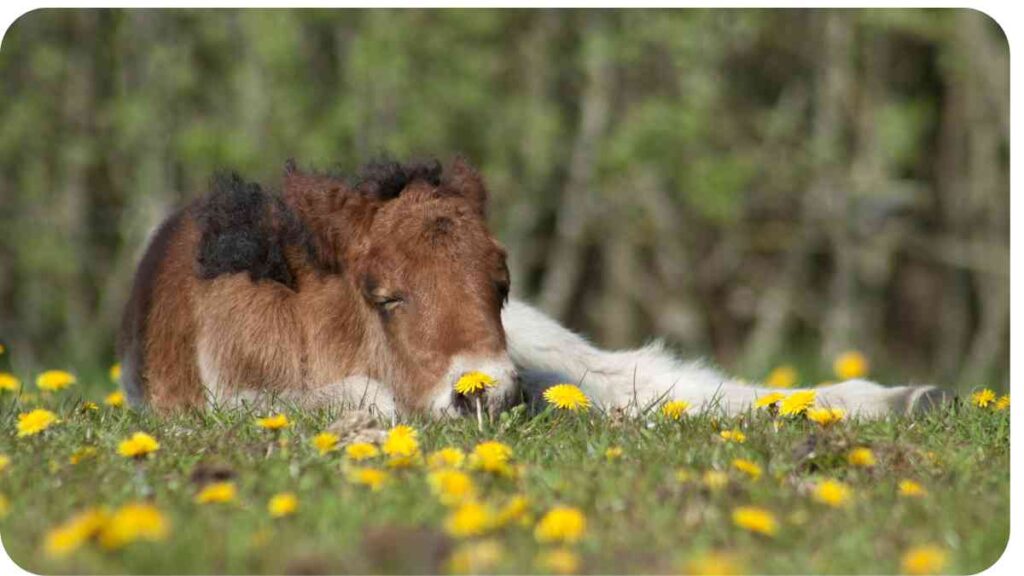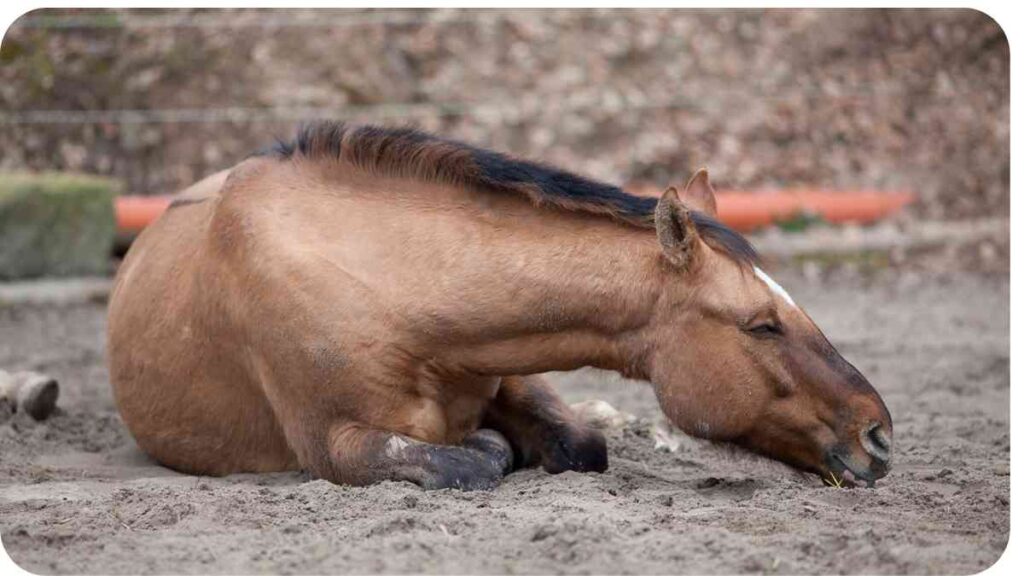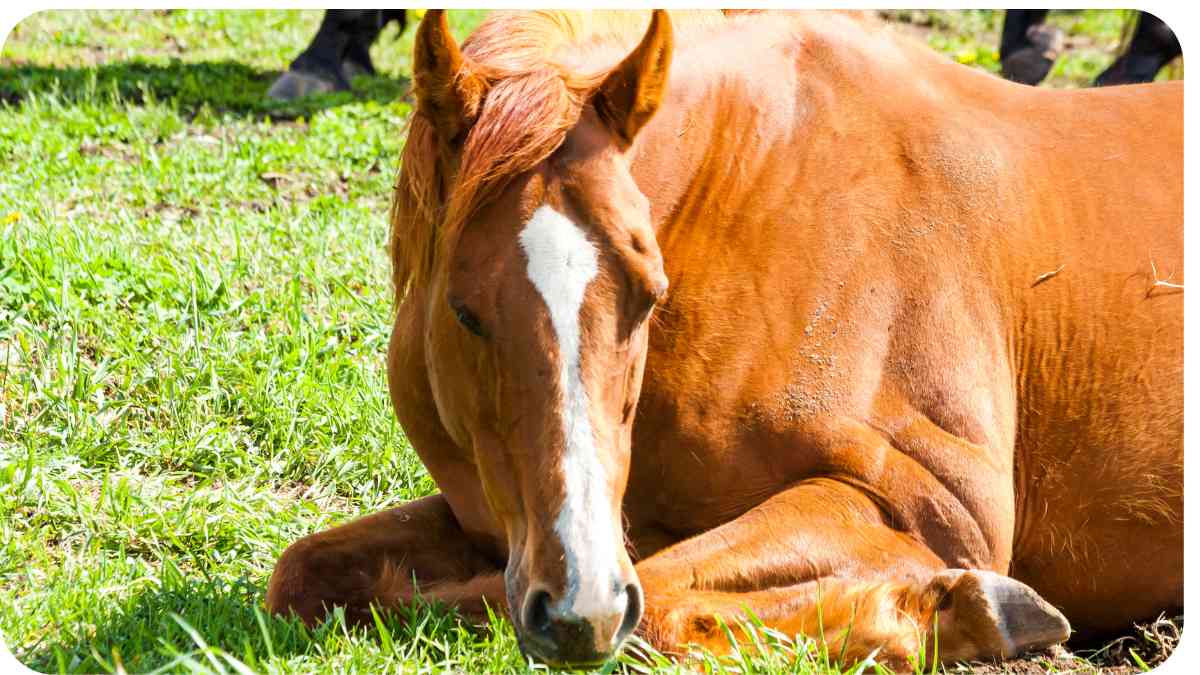Have you ever wondered how horses sleep? As an experienced equine professional, I understand the importance of proper sleep for horses’ overall well-being. In this article, we will explore the fascinating world of equine sleep patterns and discuss why it is crucial to ensure our horses get the rest they need. We’ll also debunk some common myths surrounding equine sleep.
So, let’s dive in and uncover the mysteries of how horses sleep!
| Takeaways |
| Horses require both standing and lying down sleep for optimum rest |
| Sleep deprivation can negatively impact a horse’s performance |
| Creating a comfortable environment promotes healthy sleep habits |
| Horses experience REM sleep and can exhibit dream-like movements |
| Understanding equine sleep patterns is crucial for their well-being |
Understanding Equine Sleep Patterns
Defining Equine Sleep
Before we delve into the intricacies of equine sleep patterns, let’s first understand what sleep means for horses. Like humans, horses require sleep to rejuvenate and heal their bodies. However, the way horses sleep differs from our own. Horses are unique in their ability to sleep both standing up and lying down, which is known as “polyphasic sleep.”
Regular dental care is essential for maintaining a horse’s health and comfort. It’s crucial to keep their teeth in top shape to ensure proper dental care and contribute to overall well-being, including sound sleep patterns.
Different Sleep Stages in Horses

Similar to humans, horses experience different sleep stages. These stages are categorized into two main types: Rapid Eye Movement (REM) sleep and Non-Rapid Eye Movement (NREM) sleep. REM sleep is often referred to as “dream sleep” and is characterized by quick eye movements and increased brain activity. NREM sleep is further divided into three stages: N1, N2, and N3.
Sleep Duration in Horses
On average, horses spend about three hours in REM sleep, which accounts for around 15-20% of their total sleep time. The remaining sleep time is divided among NREM sleep stages. It’s important to note that horses may not experience REM sleep every time they enter a sleep cycle, unlike humans who enter REM sleep regularly.
Sleep Patterns of Foals and Adult Horses
Foals, especially newborns, require more sleep than adult horses. They spend a significant portion of their time sleeping, with shorter periods of wakefulness for nursing and play. As foals grow older, their sleep patterns gradually resemble those of adult horses.
After a ride, it’s important to remember the significance of a proper cooldown for your horse. Learn how to ensure their post-activity recovery with this comprehensive cooling down guide to promote better sleep.
Adult horses typically sleep for short periods throughout the day and night, totaling approximately three hours of sleep in a 24-hour period.
| Age Group | Sleep Duration | Typical Sleep Patterns |
| Foals | Up to 14-16 hours per day | Short naps throughout the day |
| Adult Horses | Approximately 3 hours per day | Short periods of sleep throughout 24h |
Understanding the sleep patterns of horses helps us tailor their daily routines and ensure they receive adequate rest and rejuvenation. It’s crucial to acknowledge the importance of proper sleep for horses’ overall well-being.
The Importance of Proper Sleep for Horses

Proper sleep is vital for horses’ physical and mental health. Just like humans, horses need quality sleep to repair tissues, regulate their metabolism, and strengthen their immune system. Sleep also plays a crucial role in cognitive function and memory consolidation.
Without sufficient sleep, horses may experience a range of negative effects, including decreased performance, irritability, and compromised overall well-being.
Horses that don’t get enough sleep may suffer from sleep deprivation, which can lead to a variety of health issues. When deprived of proper rest, horses become more susceptible to stress, reduced immune function, and impaired cognitive abilities.
Sleep deprivation can also affect a horse’s coordination, balance, and reaction time, jeopardizing their safety and potentially leading to accidents or injuries.
Understanding your horse’s vision is key to comprehending their needs and behavior. This comprehensive guide to horse vision can shed light on how their sight influences their sleep patterns
How Environment Affects Equine Sleep
The sleeping patterns of horses can be influenced by their environment, whether they are domesticated or living in the wild. Understanding these differences allows us to create an optimal sleep environment for our horses.
Sleep in Domesticated Horses
Domesticated horses often need to adapt to human schedules and routines, which can impact their sleep patterns. Factors such as stable confinement, artificial lighting, and noise pollution can disrupt their natural sleep-wake cycles. To mitigate these effects, it’s crucial to provide a comfortable and quiet sleeping space for domesticated horses, replicating natural conditions as closely as possible.
Sleep in Wild Horses
Wild horses have the freedom to choose their sleeping arrangements and environments. They often form groups or bands and exhibit a phenomenon called “group sleep.” In this scenario, one or more horses will remain standing while others lie down, keeping watch for potential threats.
This group sleep behavior ensures the herd’s safety while allowing individual horses to get the rest they need. Wild horses can choose open spaces or sheltered areas for sleep, which offers them a greater sense of security.
Can horses swim? Discover various options for incorporating water activities into your horse’s routine. Knowing how to manage this aspect of their lives can affect their overall health, which includes swimming options that might impact their sleep patterns.
By understanding the impact of their environment on equine sleep, we can make informed decisions to provide horses with the best possible conditions for rest and rejuvenation.
Common Sleeping Positions in Horses
Horses can sleep in a variety of positions, both standing up and lying down. Each position serves a purpose and reflects the horse’s level of relaxation and comfort. Here are some common sleeping positions among horses:
- Standing Sleep: Horses have the unique ability to sleep while standing. They can lock their joints using a stay apparatus, allowing them to rest without exerting much effort. In this position, horses often lower their heads, relax their muscles, and may even close their eyes.
- Lateral Recumbency: When horses lie down on their sides, it’s called lateral recumbency. This position allows horses to enter deeper sleep stages, especially during REM sleep. Lateral recumbency is a sign of relaxation and can indicate that the horse feels secure.
- Sternal Recumbency: In sternal recumbency, horses rest on their sternum with their legs tucked underneath them. This position offers a compromise between standing and lying fully down. Horses in sternal recumbency are often seen dozing or taking short naps.
- Supine Recumbency: Supine recumbency is when a horse lies completely flat on its side. Horses typically enter REM sleep in this position and can often exhibit vivid dream-like movements. They may also stretch out their legs or roll onto their back briefly before returning to a more relaxed position.
| Sleeping Position | Description |
| Standing Sleep | Horses sleep while standing up, locking their joints using the stay apparatus. They lower their heads, relax their muscles, and may close their eyes, indicating a state of relaxation. |
| Lateral Recumbency | Horses lie down on their sides, allowing them to enter deeper sleep stages, particularly during REM sleep. This position signifies relaxation and security. |
| Sternal Recumbency | Horses rest on their sternum with their legs tucked underneath them. This position is ideal for short naps and dozing. |
| Supine Recumbency | Horses lie completely flat on their side, often exhibiting REM sleep in this position. They may experience vivid dream-like movements and may briefly roll onto their back. |
Understanding the various sleeping positions of horses helps us gauge their level of relaxation and comfort. It is essential to provide an environment that encourages and accommodates their unique sleep preferences.
Before hitting the trails with your horse, it’s crucial to be well-versed in horse riding etiquette. This knowledge can help ensure a positive riding experience, which, in turn, might positively impact your horse’s sleep patterns. Learn the essentials of trail riding etiquette today!
Signs of Sleep Deprivation in Horses
As responsible horse owners or caregivers, it’s crucial to be aware of the signs of sleep deprivation in horses to ensure their well-being. Here are some indicators that may suggest a horse is not getting enough sleep:
- Increased Irritability: Sleep-deprived horses may become more easily agitated and display signs of irritability. They might exhibit excessive sensitivity to touch or sound.
- Reduced Performance: Sleep deprivation can negatively impact a horse’s performance. They may have difficulties concentrating, learning new tasks, or cooperating during training sessions.
- Lethargy and Lack of Energy: Horses that lack sufficient sleep may appear lethargic, with decreased overall energy levels. They may be less willing to engage in physical activities or exhibit a general lack of enthusiasm.
- Alterations in Appetite: Sleep deprivation can affect a horse’s appetite. Some horses may experience a reduced interest in food, while others may exhibit an increase in appetite as their body attempts to compensate for inadequate rest.
- Changes in Behavior and Temperament: Sleep-deprived horses may display altered behavior patterns, such as restlessness, anxiety, or increased sensitivity to stimuli.
If you notice any of these signs in your horse, it is crucial to evaluate their sleeping conditions and consult with a veterinarian if necessary. Prioritizing and ensuring proper sleep for your horse is essential for their overall health and well-being.
Tips for Promoting Healthy Sleep in Horses
Creating an environment that promotes healthy sleep habits is paramount to ensure your horse’s well-being. Here are some tips to help you provide the best possible conditions for your horse’s sleep:
- Creating a Comfortable Sleeping Environment: Design a suitable resting area for your horse that is clean, spacious, and free from distractions or excessive noise. Providing a soft and comfortable bedding material, such as straw or shavings, can enhance their sleeping experience.
- Maintaining a Consistent Routine: Horses thrive on routine. Establish a consistent daily routine that incorporates feeding, exercise, and rest periods. By sticking to a schedule, you can help regulate their sleep-wake cycles and promote better sleep habits.
- Providing Adequate Exercise and Mental Stimulation: Regular exercise and mental stimulation during the day can help horses expend energy, reduce anxiety, and promote better sleep at night. Engaging in activities like grooming, ground training, or providing access to turnout can aid in their overall well-being and sleep quality.
- Ensuring Proper Nutrition and Hydration: A balanced diet and access to fresh water are essential aspects of maintaining a healthy sleep routine for your horse. Proper nutrition and hydration support their overall health, including the quality of their sleep.
- Regular Health Checks and Preventive Care: Regular veterinary check-ups and preventive care measures, such as deworming and dental exams, help ensure your horse’s optimal health. Addressing any underlying health issues can contribute to better sleep quality.
By implementing these tips, you can create an environment that facilitates restful sleep for your horse, allowing them to wake up refreshed and ready for their daily activities.
Myth Busting: Common Misconceptions about Equine Sleep
There are several misconceptions and myths circulating about how horses sleep. Let’s debunk some of these common misunderstandings:
- Myth: Horses only sleep while standing up.
- While it is true that horses can sleep while standing up, they also lie down to enter deeper sleep stages. Horses require both standing and lying down sleep for optimal rest and rejuvenation.
- Myth: Horses never enter REM sleep.
- Horses do experience REM sleep, although it occurs for shorter durations compared to humans. REM sleep is crucial for memory consolidation and cognitive function.
- Myth: Horses sleep for long periods at a time.
- Horses sleep in shorter, intermittent periods throughout the day and night. They undergo multiple sleep cycles, which include both REM and NREM sleep stages.
- Myth: Lack of sleep doesn’t affect performance in horses.
- Sleep deprivation can negatively impact a horse’s performance. Just like humans, a tired horse may have difficulties focusing, learning new tasks, and may exhibit behavioral changes.
- Myth: Horses can sleep through noise and disturbances.
- While horses have a remarkable ability to sleep through some disturbances, excessive noise or continuous disruptions can adversely affect their sleep quality.
By dispelling these misconceptions, we can gain a better understanding of horses’ sleep patterns and provide them with the care and environment they need for optimal rest.
Conclusion
Understanding equine sleep patterns is essential for ensuring the overall well-being of our horses. Proper sleep is vital for their physical and mental health, and it directly impacts their performance and quality of life.
By creating a suitable sleeping environment, maintaining consistent routines, providing adequate exercise and mental stimulation, ensuring proper nutrition and hydration, and monitoring their health, we can promote healthy sleep habits.
Remember, horses have unique sleeping positions and require both standing and lying down sleep. By respecting their natural sleep patterns, we can foster an environment that allows our horses to rest, rejuvenate, and thrive.
In conclusion, prioritizing our horses’ sleep is one of the key factors in caring for their welfare. As responsible horse owners, providing the conditions necessary for restful sleep allows our equine companions to be at their best both physically and mentally. So, let’s pay attention to their sleep needs and ensure that they have the opportunity for deep, restorative rest.
Further Reading
Here are some additional resources for further exploration of equine sleep patterns:
- Horse Racing Sense – How Horses Sleep: A Comprehensive Guide: This comprehensive guide provides detailed information on how horses sleep, discussing their sleep patterns, positions, and the factors that affect their sleep.
- Animal Friends – How Do Horses Sleep?: This article offers insights into equine sleep behavior and discusses the various positions horses assume when sleeping. It also touches on the impact of stable management practices on their sleep patterns.
- PubMed Central – Ethology of Sleep in Equidae: This scientific paper delves into the ethology of sleep in horses and provides a thorough analysis of equine sleep behavior, sleep stages, and the impact of different environmental factors on equine sleep.
These resources can provide you with a deeper understanding of equine sleep patterns, ensuring you have a comprehensive knowledge base for taking care of your horse’s sleep needs.
FAQs
Here are some frequently asked questions about equine sleep:
How long do horses sleep each day?
Horses typically sleep for short periods throughout the day and night, amounting to approximately three hours of sleep in a 24-hour period.
Can horses sleep standing up?
Yes, horses have the ability to sleep both standing up and lying down. They employ a stay apparatus to lock their joints and rest while standing.
Do horses dream?
Horses experience REM (Rapid Eye Movement) sleep, often associated with dreaming. During REM sleep, horses may exhibit vivid dream-like movements.
How can I create a suitable sleeping environment for my horse?
Creating a comfortable and quiet sleeping area, providing soft bedding, and minimizing distractions can help create an optimal sleeping environment for your horse.
What are the signs of sleep deprivation in horses?
Signs of sleep deprivation in horses can include increased irritability, reduced performance, lethargy, changes in appetite, and alterations in behavior and temperament.
Feel free to explore more questions and answers to deepen your knowledge about equine sleep and its significance for your horse’s well-being.

Hi there! My name is Hellen James, and I’m a horse riding expert. I’ve been riding horses since I was just a kid—and it’s been my passion ever since. But getting started with horse riding can be overwhelming. There’s so much to learn! If you’re looking for a way to get started and make sure you’re doing it right, I’m here to help.


